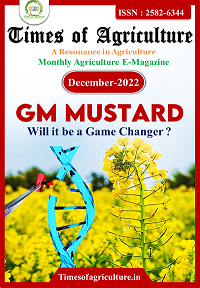GM MUSTARD: Will it be a Game Changer? – A bench of scientists are supporting it whereas, on the other hand, the fear and reservations expressed in some quarters. In fact, such objections are not new. They were also expressed when we imported the dwarf miracle seeds of wheat and rice to achieve food self-sufficiency through the Green Revolution. The same concerns were raised when Bt-Cotton was being released. Science-led revolutions have given India self-respect and global recognition.
In 2020-21, around 13.3 million tonnes of edible oil were imported at a cost of ₹1,17,000 crore. Interestingly, of this, 2.0-2.5 mt soybean oil and 1.0-1.5 mt canola oil is already GM. Hence, we are consuming GM oil already, besides, the 1.5 mt of GM cotton oil produced domestically.
Moreover, it is scientifically proven that the consumption of refined oil does not allow any protein to enter the human system. Thus, the consumption of GM oil is completely safe from a health point of view.
Mustard statistics
Mustard (Brassica juncea) is cultivated in 6-7 million hectares during the Rabi winter season predominantly in Rajasthan, Haryana, Punjab and Madhya Pradesh. India imports about 55-60% of its domestic edible-oil requirement. This is primarily due to low productivity of about 1-1.3 t/ha that has been stagnant for over two decades.
Between Oct. 1 and Nov. 15, the total oil-seed area touched 7.6 million hectares, up from 6.7 million hectares during the same period last year. Although a major concern of our farmers is that yields of mustard are low and have stagnated for a long time at around 1,260 kg/ha, much lower than the global average of 2,000 kg/ha.
Yields of canola in Canada, China and Australia are almost three times higher than in India since they use GM hybrid technology. Thus, the government’s decision to allow the production of GM Mustard hybrids will go a long way in increasing our yields, while reducing the use of pesticides and import of edible oil as well.
The story so far of GM Mustard
The Genetic Engineering Appraisal Committee (GEAC), India’s apex regulator of genetically modified plants and food products, has approved the environmental release of Dhara Mustard Hybrid-11 (DMH-11), a genetically-engineered variant of mustard. If approved for commercial cultivation it would be the first genetically modified food crop available to Indian farmers.
What is DMH-11?
DMH-11 is a transgenic hybrid variant of mustard developed by researchers at Delhi University’s Centre for Genetic Manipulation of Crop Plants (CGMCP). It began with DMH-1, a hybrid variant that was developed without transgenic technology. DMH-1 was approved for commercial release in northwest India in 2005-2006 but it is not cost-effective because hybridisation isn’t easy in mustard. As is a self-pollinating crop and therefore it is challenging to cross different varieties and induce desirable traits. Being able to turn off this self-pollinating trait to enable such crossings and then restoring the trait, to enable seed production, is how the mustard plant’s genes are to be manipulated. By genetic modification, scientists have developed the hybrid mustard DMH-11 containing two alien genes isolated from a soil bacterium called Bacillus amyloliquefaciens.
The Barnase/Barstar GM Technology
The first gene ‘barnase’ codes for a protein that impairs pollen production and renders the plant into which it is incorporated male-sterile. This plant is then crossed with a fertile parental line containing the second gene ‘barstar’ that blocks the action of the barnase gene. The resultant F1 progeny is both high-yielding and also capable of producing seed/ grain, thanks to the barstar gene in the second fertile line.

The CGMCP scientists have deployed the barnase-barstar GM technology to create a robust and viable hybridisation system in mustard. This system was used to develop DMH-11 by crossing a popular Indian mustard variety ‘Varuna bn 3.6’ (the barnase line) with an East European ‘Early Heera-2 modbs 2.99’ mutant (the barstar line). The result is DMH-11 (where 11 refers to the number of generations after which desirable traits manifest) that not only has better yield but is also fertile. DMH-11 is a transgenic crop because it uses foreign genes from a different species.
Are hybrid mustard varieties better?
ICAR conducted trials at 8 locations over 3 years and suggest that DMH-11 has 28% higher yields than its parent Varuna and was 37% better than zonal checks, or local varieties that are considered the best in different agro-climatic zones (ICAR, 2022).
What has GEAC now done?
In this case, it has recommended the environmental release of DMH-11 “for its seed production and testing prior to commercial release”, a green signal for commercial cultivation by farmers. GEAC has also recommended the environmental release of DMH-11’s parental lines (carrying the barnase and barstar genes) for them to be used to develop new hybrids. Such hybrids could give even higher yields than DHM-11.
So, will Indian farmers plant GM mustard?
Definitely not this year, since there are no seeds available and the planting season for the crop (October to early-November) is virtually over. The IARI has said that the crop would be commercially available after three seasons now that they can be grown in large quantities for evaluation. Also, it remains to be seen if the central government will accept the GEAC’s recommendations.
Why is it controversial about GM Mustard? Why did it take so long for GEAC to clear?
There are two main reasons why transgenic mustards are a topic of debate. The first is the use of genes that are foreign to the species. Secondly, the presence of a third ‘bar’ gene, which makes GM mustard plants tolerant to the spraying of glufosinate ammonium, a herbicide. This, the opponents allege, will cause displacement of manual labour and promote use of chemical herbicides.
The DMH-11 developers, however, say that bar is only a marker gene. It is used to identify those plants that have been genetically modified – the non-GM ones cannot withstand application of the herbicide – and necessary for large-scale seed production. The GEAC has recommended the “usage of any formulation of herbicide exclusively for hybrid seed production”, while not permitting the same “for cultivation in the farmer’s field under any situation”.
Will GM mustard prove as a catastrophe for honeybees?
The concern over GM mustard is threatening or undermining the population of honey bees and this could have knock-off environmental catastrophes.
However, the GEAC has cited the report of an expert committee which stated that “based on the examination of scientific evidences available globally it seems unlikely that the bar, barnase and barstar system will pose an adverse impact on honey bees and other pollinators”
-The Indian Express, 2022.
The GEAC has, at the same time, recommended that the applicant (CGMCP) should conduct “field demonstration studies with respect to the effect of (GM mustard) on honey bees and other pollinators” post the environmental release, “to generate scientific evidence in the Indian agro-climatic situation and as a precautionary mechanism”.
What next for GM mustard?
This isn’t the first time that the GEAC has cleared the environmental release of GM mustard. In 2017 too, the apex body had cleared it but the process got stalled after a case was lodged in the Supreme Court. Bt-Brinjal, the first transgenic food crop, too was cleared by the GEAC in 2009 but was put on hold by the then government on the grounds that more tests were needed. Currently the only transgenic crop grown in India is Bt-cotton. The GEAC go-ahead only allows DMH-11 to be grown in fields under the supervision of the ICAR.
Even as the Supreme Court has called for status quo on planting genetically modified mustard, jeopardising the latest GEAC “environmental” release of DMH-11, for many the latter’s nod in itself is a milestone in the history of Indian agriculture research.
The compelling motive here could be India’s spiraling edible oil import bill. The country produces only 8.5-9 mt of edible oil annually, while importing 14-14.5 mt which costs a huge amount of $18.99 billion in the fiscal year ended March 31, 2022.
-Directorate of Economics and Statistics, 2022)
DMH-11 rather than being an end in itself signals the proof of success of the barnase-barstar system that can act as a platform technology to develop newer hybrids. This system of hybrid seed production provides hybrid seed with high purity and can be transferred to any set of combiners using backcross breeding, as compared to conventional Cytoplasmic Male Sterility (CMS) systems. Moreover, mustard varieties in India have a narrow genetic base. The barnase-barstar system enables breeding of hybrids from a wider range of mustards, including those of East European origin such as ‘Heera’ and ‘Donskaja’. New traits relating to resistance against disease (Alternaria blight and stem rot fungus) or Canola oil quality (zero/ low levels of erucic acid and glucosinolates) can also be introduced.

- November Issue 2025- Times of Agriculture Magazine
- Punjab & Sind Bank Introduces Special Program to Support Food and Agro-Processing Sector
- Beyond Classrooms and Gardens: How a Professor Turned His Passion into Purpose
- October Issue 2025- Times of Agriculture Magazine
- Top 10 Pesticide Companies in the World
- September Issue 2025- Times of Agriculture Magazine








